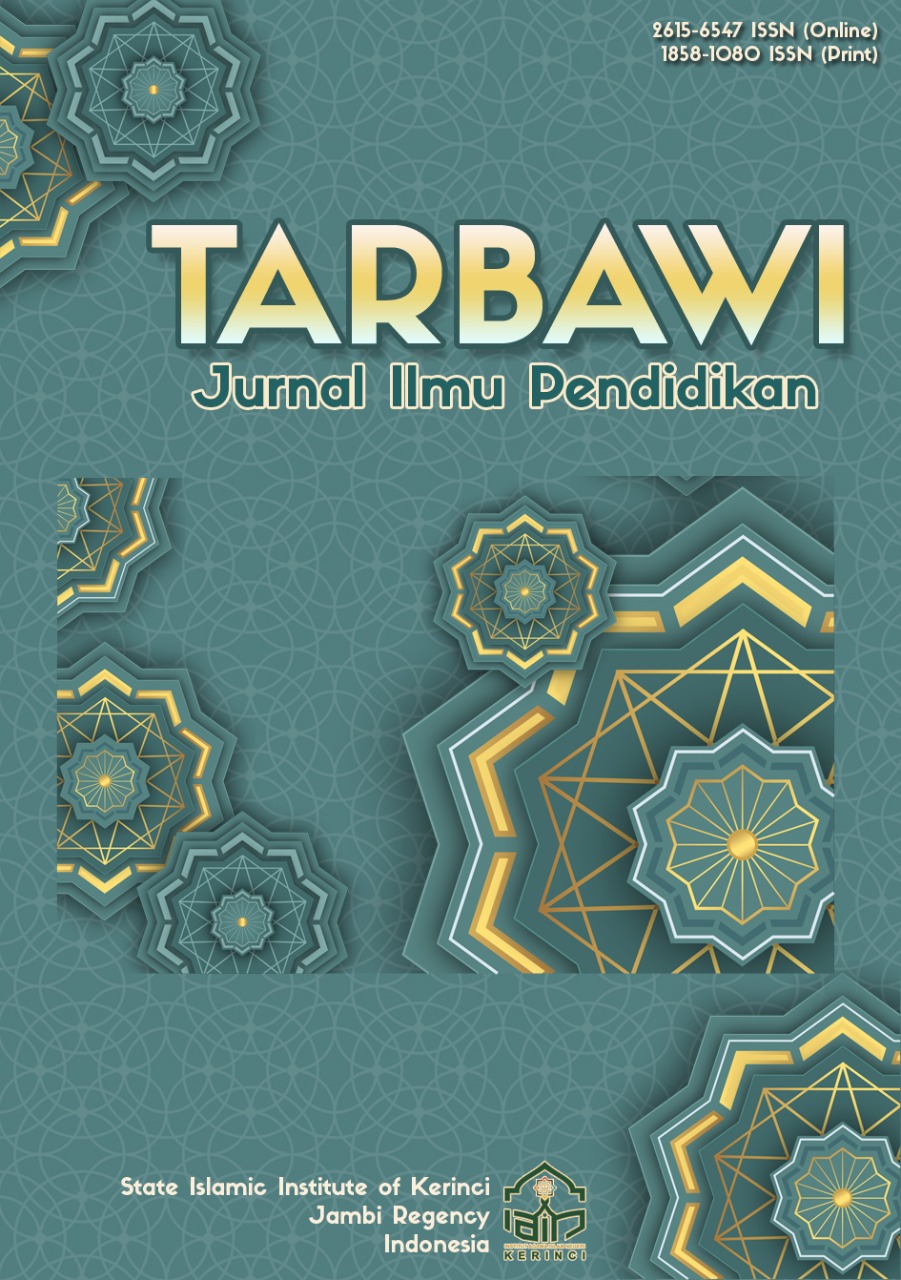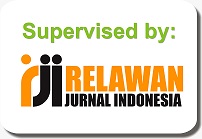The Influence of School Principals' Digital Leadership and Teacher Self-Efficacy on Teacher Technology Use
DOI:
https://doi.org/10.32939/tarbawi.v20i2.4291Keywords:
Digital Leadership, Teacher Self-Efficacy , Teacher’s Technology UseAbstract
The purpose of the study was to see how the effect of digital leadership and teacher self-efficacy on teacher technology use. The study used a quantitative approach. The study began in March-May 2024. This study used a simple random sampling technique. The sample of this study was 169 teachers. The study was conducted in high schools in Sleman Regency, Yogyakarta. Data analysis used simple linear regression and multiple linear regression. Data collection techniques used questionnaires and documentation. The results of the study were that digital leadership had an impact on teacher technology use by an R2 value of 0.046, teacher self-efficacy influenced teacher technology use by an R2 value of 0.030, and together digital leadership and teacher self-efficacy influenced teacher technology use by an R2 value of 0.118. . Future researchers can conduct research by considering other variables that can influence technology use.
Downloads
References
AlAjmi, M. K. (2022). The impact of digital leadership on teachers’ technology integration during the COVID-19 pandemic in Kuwait. International Journal of Educational Research, 112, 101928. https://doi.org/https://doi.org/10.1016/j.ijer.2022.101928https://doi.org/10.1016/j.ijer.2022.101928
Aljohani, N. J. (2022). Teacher Self-Efficacy Beliefs and the Integration of Interactive Website Wikispaces Classroom. International Journal of Web-Based Learning and Teaching Technologies, 17(1), 1–17. https://doi.org/10.4018/ijwltt.313192https://doi.org/10.4018/IJWLTT.313192
Backfisch, I., Lachner, A., Hische, C., Loose, F., & Scheiter, K. (2020). Professional knowledge or motivation? Investigating the role of teachers’ expertise on the quality of technology-enhanced lesson plans. Learning and Instruction, 66, 101300. https://doi.org/10.1016/j.learninstruc.2019.101300
Buchholz, B. A., DeHart, J., & Moorman, G. (2020). Digital citizenship during a global pandemic: Moving beyond digital literacy. Journal of Adolescent & Adult Literacy, 64(1), 11–17. https://doi.org/10.1002/jaal.1076
Coman, C., Țîru, L. G., Meseșan-Schmitz, L., Stanciu, C., & Bularca, M. C. (2020). Online teaching and learning in higher education during the coronavirus pandemic: Students’ perspective. Sustainability, 12(24), 10367. https://doi.org/10.3390/su122410367
Cuban, L. (2001). Oversold and underused: Computers in the classroom. Harvard university press.
Dewantoro, D., & Andriani, D. E. (2022). Permasalahan-permasalahan Pendidikan yang Dihadapi Sekolah di Tahun Pertama Pandemi Covid-19. Jurnal Manajemen Pendidikan: Jurnal Ilmiah Administrasi, Manajemen Dan Kepemimpinan Pendidikan, 4(1), 97–113.
Dikkers, S. M. (2013). Promote the use of the most effective and appropriate technologies to support teaching and learning. In The new instructional leadership (pp. 147–167). Routledge.
Dinçer, S. (2018). Are preservice teachers really literate enough to integrate technology in their classroom practice? Determining the technology literacy level of preservice teachers. Education and Information Technologies, 23, 2699–2718. https://doi.org/10.1007/s10639-018-9737-z
Ediyanto, E., Sunandar, A., Ramadhani, R. S., & Aqilah, T. S. (2022). Sustainable Instrument Development in Educational Research. Discourse and Communication for Sustainable Education, 13(1), 37–47. https://doi.org/10.2478/dcse-2022-0004https://doi.org/10.2478/dcse-2022-0004
Eryeşil, K. (2021). Digital leadership, leadership paradigm of the digital age: A conceptual framework. Equinox Journal of Economics Business and Political Studies, 8(1), 98–112. https://doi.org/10.48064/equinox.885320
Fullan, M. (2015). The new meaning of educational change. Teachers college press.
Garcia, R. (2020). Leading for Excellence: Leadership Behaviors that Support a High-Achieving School Climate. Brandman University.
Ghozali, I. (2016). Aplikasi analisis multivariete dengan program IBM SPSS 23.
Gilkes, A. L. (2020). Teachers’ knowledge and self-efficacy beliefs as factors affecting technology integration practices. Walden University.
Gomez, F. C., Trespalacios, J., Hsu, Y.-C., & Yang, D. (2022). Exploring teachers’ technology integration self-efficacy through the 2017 ISTE Standards. TechTrends, 1–13. https://doi.org/10.1007/s11528-021-00639-z
Guillen, D., Gomez, D., Hernandez, I., Charris, D., Gonzalez, J., Leon, D., & Sanjuan, M. (2020). Integrated methodology for industrial facilities management and design based on FCA and lean manufacturing principles. Facilities, 38(7/8), 523–538. https://doi.org/10.1108/F-03-2019-0040
Haixia, L., Koehler, M., & Wang, L. (2018). The impact of teachers’ beliefs on their different uses of technology. Society for Information Technology & Teacher Education International Conference, 1468–1477.
Haleem, A., Javaid, M., Qadri, M. A., & Suman, R. (2022). Understanding the role of digital technologies in education: A review. Sustainable Operations and Computers, 3, 275–285. https://doi.org/10.1016/j.susoc.2022.05.004
Hidayah, R., Susiani, T. S., & Salimi, M. (2020). How elementary school teachers use ICT-based learning media? Journal of Physics: Conference Series, 1511(1), 12015.
Ismail, S. N., Omar, M. N., & Raman, A. (2021). The authority of principals’ technology leadership in empowering teachers’ self-efficacy towards ict use. International Journal of Evaluation and Research in Education, 10(3), 878–885. https://doi.org/10.11591/ijere.v10i3.21816
Kundu, A., Bej, T., & Dey, K. N. (2020). An empirical study on the correlation between teacher efficacy and ICT infrastructure. International Journal of Information and Learning Technology, 37(4), 213–238. https://doi.org/10.1108/IJILT-04-2020-0050https://doi.org/10.1108/IJILT-04-2020-0050
Lawrence Neuman, W. (2014). Social research methods: Qualitative and quantitative approaches. Pearson.
Leary, H., Lee, V. R., & Recker, M. (2021). It’s more than just technology adoption: Understanding variations in teachers’ use of an online planning tool. TechTrends, 65(3), 269–277. https://doi.org/10.1007/s11528-020-00576-3
Li, Y., Garza, V., Keicher, A., & Popov, V. (2019). Predicting high school teacher use of technology: Pedagogical beliefs, technological beliefs and attitudes, and teacher training. Technology, Knowledge and Learning, 24, 501–518.
Maria, P., Wahyuningrum, E., Jamil, M. A., Nawawi, M. L., Aditia, D., Gusti, N., & Lia, A. (2023). Analisis Efektivitas Penggunaan Teknologi dalam Pendidikan Terhadap Peningkatan Hasil Belajar. 06(01), 1–11.
Martínez-Caro, E., Cegarra-Navarro, J. G., & Alfonso-Ruiz, F. J. (2020). Digital technologies and firm performance: The role of digital organisational culture. Technological Forecasting and Social Change, 154, 119962. https://doi.org/10.1016/j.techfore.2020.119962
Means, B. (1994). Technology and education reform: The reality behind the promise. (No Title).
Moore-Hayes, C. (2011). Technology Integration Preparedness and its Influence on Teacher-‐Efficacy. Canadian Journal of Learning and Technology, 37(3), 1–15. https://doi.org/10.21432/T2B597
Musid, N. A., Matore, M. E. E. M., & Hamid, A. H. A. (2022). Digital Leadership with The Constructs Diversity: A Systematic Literature Review. Mathematical Statistician and Engineering Applications, 71(4), 2182–2202.
Nuere, S., & De Miguel, L. (2021). The digital/technological connection with COVID-19: An unprecedented challenge in university teaching. Technology, Knowledge and Learning, 26(4), 931–943.
O’Neal, L. J., Gibson, P., & Cotten, S. R. (2017). Elementary school teachers’ beliefs about the role of technology in 21st-century teaching and learning. Computers in the Schools, 34(3), 192–206. https://doi.org/10.1080/07380569.2017.1347443
Oberer, B., & Erkollar, A. (2018). Leadership 4.0: Digital leaders in the age of industry 4.0. International Journal of Organizational Leadership.
Ray, B., Ed, D., Lee, S., Ph, D., & Education, K.-. (2018). Teachers ’ Perceptions of Principal Digital Leadership Behaviors that Impact Technology Use in The Classroom. Dallas Baptist University ProQuest Dissertations Publishing. https://doi.org/10981886
Raygan, A., & Moradkhani, S. (2022). Factors influencing technology integration in an EFL context: investigating EFL teachers’ attitudes, TPACK level, and educational climate. Computer Assisted Language Learning, 35(8), 1789–1810.
Reaves, S. J., & Cozzens, J. A. (2018). Teacher perceptions of climate, motivation, and self-efficacy: Is there really a connection. Journal of Education and Training Studies, 6(12), 48–67.
Rusnati, I., & Gaffar, M. F. (2021). Implementation of Pr incipal ’ s Digital Leadership in Communication and Teacher Professional Development at School. 526(Icream 2020), 90–95.
Schmid, R., Pauli, C., & Petko, D. (2023). Examining the use of digital technology in schools with a school-wide approach to personalized learning. Educational Technology Research and Development, 71(2), 367–390. https://doi.org/10.1007/s11423-022-10167-z
Sheninger, E. (2019). Digital leadership: Changing paradigms for changing times. Corwin Press. https://doi.org/10.21125/inted.2019.2528
Sugiyono, S. (2019). Metodologi Penelitian Kualitatif Kuantitatif Dan R&D. Bandung: Cv. Alfabeta.
Taufiqurrahman. (2021). Kepemiminan Kepala Sekolah di Era Digital. Proceeding: Islamic University of Kalimantan, 1(1). https://doi.org/10.1515/bpasts-2016-0041
Thannimalai, R., & Raman, A. (2018). Principals technology leadership and teachers technology integration in the 21st century classroom. International Journal of Civil Engineering and Technology, 9(2), 177–187.
Uğur, N. G., & Koç, T. (2019). Leading and Teaching with Technology: School Principals’ Perspective. International Journal of Educational Leadership and Management, 7(1), 42. https://doi.org/10.17583/ijelm.2019.3758https://doi.org/10.17583/ijelm.2019.3758
Wang, F., & Reeves, T. C. (2003). Why Do Teachers Need to Use Technology in Their Classrooms ? Issues , Problems , and Solutions. 20(4), 49–66. https://doi.org/10.1300/J025v20n04_05
Williams, M K, Christensen, R., McElroy, D., & ... (2023). Teacher self-efficacy in technology integration as a critical component in designing technology-infused teacher preparation programs. … Issues in Technology …, 23, 228–259. https://www.learntechlib.org/p/221546/
Williams, Mia Kim, Christensen, R., McElroy, D., & Rutledge, D. (2023). Teacher self-efficacy in technology integration as a critical component in designing technology-infused teacher preparation programs. Contemporary Issues in Technology and Teacher Education, 23(1), 228–259.
Winter, E., Costello, A., O’Brien, M., & Hickey, G. (2021). Teachers’ use of technology and the impact of Covid-19. Irish Educational Studies, 40(2), 235–246. https://doi.org/10.1080/03323315.2021.1916559https://doi.org/10.1080/03323315.2021.1916559
Xu, M., Williams, P. J., Gu, J., & Zhang, H. (2020). Hotspots and trends of technology education in the International Journal of Technology and Design Education: 2000–2018. International Journal of Technology and Design Education, 30(2), 207–224. https://doi.org/10.1007/s10798-019-09508-6
Zeng, Y. (2022). Analysing Teacher Knowledge for Technology Use among Secondary Teachers Teaching Chinese as a Foreign Language (CFL) in Australia. Journal of Curriculum and Teaching, 11(2), 15–28. https://doi.org/10.5430/jct.v11n2p15https://doi.org/10.5430/jct.v11n2p15
Downloads
Published
Issue
Section
License
Copyright (c) 2024 Saidilikhwan Saidil, Dwi Esti Andriani

This work is licensed under a Creative Commons Attribution-ShareAlike 4.0 International License.









